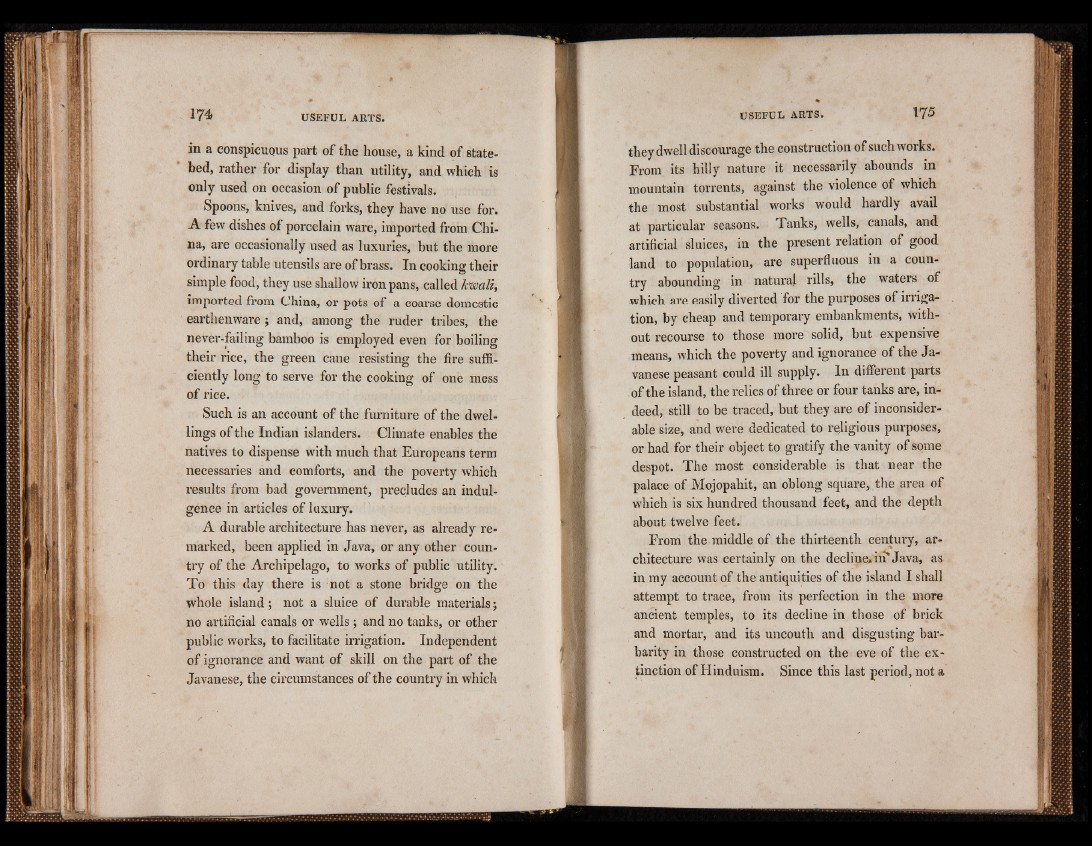
in a conspicuous part of the house, a kind of state-
bed, rather for display than utility, and which is
only used on occasion of public festivals.
Spoons, knives, and forks, they have no use for.
A few dishes of porcelain ware, imported from China,
are occasionally used as luxuries, but the more
ordinary table utensils are of brass. In cooking their
simple food, they use shallow iron pans, called kwali,
imported from China, or pots of a coarse domestic
earthenware; and, among the ruder tribes, the
never-failing bamboo is employed even for boiling
their rice, the green cane resisting the fire sufficiently
long to serve for the cooking of one mess
of rice.
Such is an account of the furniture of the dwellings
of the Indian islanders. Climate enables the
natives to dispense with much that Europeans term
necessaries and comforts, and the poverty which
results from bad government, precludes an indulgence
in articles of luxury.
A durable architecture has never, as already remarked,
been applied in Java, or any other country
of the Archipelago, to works of public utility.
To this day there is not a stone bridge on the
whole island; not a sluice of durable materials ;
no artificial canals or wells ; and no tanks, or other
public works, to facilitate irrigation. Independent
of ignorance and want of skill on the part of the
Javanese, the circumstances of the country in which
they dwell discourage the construction of such works.
From its hilly nature it necessarily abounds in
mountain torrents, against the violence of which
the most substantial works would hardly avail
at particular seasons. Tanks, wells, canals, and
artificial sluices, in the present relation of good
land to population, are superfluous in a country
abounding in natural rills, the waters of
which are easily diverted for the purposes of irrigation,
by cheap and temporary embankments, without
recourse to those more solid, but expensive
means, which the poverty and ignorance of the Javanese
peasant could ill supply. In different parts
of the island, the relics of three or four tanks are, indeed,
still to be traced, but they are of inconsiderable
size, and were dedicated to rejigious purposes,
or had for their object to gratify the vanity of some
despot. The most considerable is that near the
palace of Mojopahit, an oblong square, the area of
which is six hundred thousand feet, and the depth
about twelve feet.
From the middle of the thirteenth century, architecture
was certainly on the decline* in'Java, as
in my account of the antiquities of the island I shall
attempt to trace, from its perfection in the more
ancient temples, to its decline in those of brick
and mortar, and its uncouth and disgusting barbarity
in those constructed on the eve of the extinction
of Hinduism. Since this last period, not a